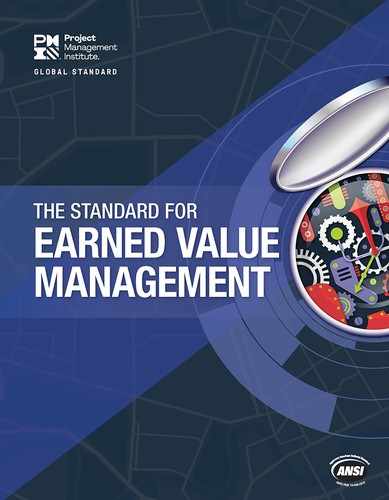166 Index
Performance measurement criteria, for project
management plan, 33–36
Physical scope units, 69
Planned value (PV), 8, 54, 90, 157
in agile approaches, 61
calculating within agile, 91–92
EVM and, 15
in managing performance, 72
Planning. See also Resource planning; Scope
planning
agreed-upon response strategies, 46
budget and schedule relationship, 49
communications, 39, 40
cost baseline, 51–52
development and integration of scope, 40–52
EVM as agile/hybrid environment, 58–62
management and contingency reserves, 47
organizational breakdown structure and, 43
performance measurement baseline for, 53–58
quality, 39, 40
resource management and, 43
risk, 39
risk management and, 45–46
rolling wave, 32
schedule baselines, 48
schedule evolution, 50–51
schedule model and, 49
schedule structure, 49
scope baselines and, 47–48
WBS and OBS integrated with RAM, 43–45
Planning earned value, 28
Planning package, 158
in scope planning, 31
Planning Process Group, 6, 27–62
applying EVM in agile/hybrid environment, 58–62
developing project management plan, 30–40
developing data and integrating baselines,
40–52
EVM flow diagram, 28
EVM project planning, 28
overview, 27–30
setting performance measurement baseline,
53–58
Planning projects
developing project management plan, 30–40
overview, 27–30
PMB. See Performance measurement baseline
PMI Lexicon of Project Management Terms, 1
PMIS. See Project management information system
PMO. See Project management office
Portfolio management, 10–13
EVM during life cycle of, 11–13
EVM for, 14
Portfolios
defined, 10
EVM measuring, 12–13
Process Groups. See also specific groups
EVM uses with, 1
mapping with Knowledge Areas, 6
project management, 6
Process improvement, 103–104
Procurement planning, 39, 40
Professional development, 66–67
Program
defined, 11
EVM measuring individual, 12–13
Program management, 10–13
EVM during life cycle of, 11–13
EVM for, 14
Project budget
performance management baseline, 54
performance management baseline, log of,
56, 57
Project charters, Initiating processes and, 18–19
Project Communications Management, 95
Project Cost Management, 37
167
Project management
EVM and, 5–7
EVM during life cycle of, 11–13
EVM for, 14
planning, 21–23
performance management baseline, maintenance of,
98–99
Project management information system (PMIS),
158
Project management office (PMO), 158
organizational process asset, support for, 16
project charter approval, 18
Project management plans
baselines, 31
cost planning, 37
developing, 30–40
performance measurement criteria, 33–36
resource planning, 37–38
resource planning considerations, 38–39
risk planning, 39
schedule planning, 32
scope planning, 31
subsidiary plans, 30–31
Project Management Process Groups, 6
Project scope, 5
Project Scope Management, 41
Project Stakeholder Management Knowledge Area,
95
Pulse of the Profession report, 13
PV. See Planned value
Q
Quality planning, 39, 40
R
RAM. See Responsibility assignment matrix
RCA. See Root cause analysis
Rebaselining, 102
Release, to define planned value, 15
Replanning, 102
Reporting, 91
bar charts, 96
curves, 96
stakeholder and communication considerations,
96–97
tables, 96
Reprogramming, 102
Resource management, 43
Resource planning, 37–38
considerations for project management plan, 38–39
Response strategies, agreed-upon, 46
Responsibility assignment matrix (RAM), 158
planning and, 43–45
resource planning and, 37–38
Risk management, planning and, 45–46
Risk planning, 39
Rolling wave concept, future scope and, 42
Rolling wave planning, 32
Root cause analysis (RCA), 158
EVM for, 14
S
SAC. See Schedule at completion
Schedule
development and integration of, 40–52
EVM integrating scope, cost and, 14
Schedule at completion (SAC), 90, 158
in managing performance, 72
Schedule baselines, 48
Schedule data, 70
Schedule evolution, 50–51
Schedule model, 48–50
Schedule performance index (SPI), 8, 79–82, 90, 109, 158
formulas for EVM, 81
168 Index
Schedule planning, 32
Schedule structure, 49
Schedule variance (SV), 8, 90, 158
Scheduled variance expressed in time (SV
t
), 76–78
Scheduled variance expressed in volume (SV
w
), 76,
77–78
Scope
in agile approaches, 61
development and integration of, 40–52
EVM integrating cost, schedule and, 14
future, 42
Scope baseline, 47–48
Scope change analysis, 100–101
Scope data, 69
Scope planning, 31
Scrum framework measures, 59
SPI. See Schedule performance index
Stakeholder and communication considerations,
95–98
external communications, 98
reporting, 96–97
Stakeholder engagement, 39, 40
Stakeholders, 19–20
Standard for Portfolio Management, 13
Subsidiary management plans, 30, 31, 71
Summary-level budget, 158
SV. See Scheduled variance
SV
t
. See Scheduled variance expressed in time
SV
w
. See Scheduled variance expressed in volume
T
TCPI. See To-complete cost performance index
Teamwork, EVM and, 15
To-complete cost performance index (TCPI), 8, 59, 79,
81, 90, 158
in forecasting, 87
To-complete performance indexes, 87, 88, 108
To-complete schedule performance index (TSPI), 80–81,
90, 158
in forecasting, 87
Trend analysis, 89–90
Trend variances, 87
TSPI. See To-complete cost performance index
U
Undistributed budget (UB), 158
performance measurement baseline and, 55
V
VAC. See Variance at completion
Variance at completion (VAC), 8, 158
forecasting, 86
Variance threshold, 71, 159
Velocity, 15
W
WBS. See Work breakdown structure
WBS dictionary. See Work breakdown structure (WBS)
dictionary
Work authorization, performance measurement baseline,
56
Work breakdown structure (WBS), 159
planning and, 43–45
resource planning and, 37–38
for scope planning, 31
for successful EVM, 29
Work breakdown structure (WBS) dictionary, 159
Work package (WP), 159
scope planning and, 31
for successful EVM, 29
W P. See Work package
..................Content has been hidden....................
You can't read the all page of ebook, please click here login for view all page.
